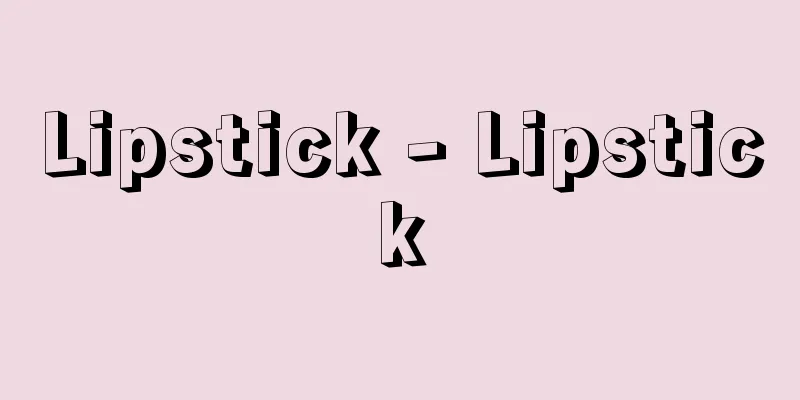Lipstick - Lipstick

|
Cosmetics applied to the lips. The French word is rouge. There are some that are mainly red in color and make the lips look attractive and healthy, and some that give the lips a glossy look. They consist of an oily base and coloring agents, and come in stick, ointment, and liquid forms, with the stick form being the most commonly used. [Fumisako Yokota] WesternToday, lipstick is almost always a stick type, but in the West, rouge has been used up until very recently as a cosmetic applied to both cheeks and lips. The origins of lipstick makeup, which colors and shapes the lips, are unclear, but ancient Egypt already had cream-like rouge, which was also used on the lips. However, Egyptian makeup was primarily used to color the eyes. In Greece, lips were colored with a brownish red or dark purple rouge, which was made from seaweed, mulberry fruit, purple shells, and cinnabar (red mercury sulfide). Rouge continued to be used in Rome, and Spanish wool (a cloth tape colored red) appeared in the Middle Ages, but rouge was a cosmetic used to redden the cheeks rather than the lips. The custom of wearing lipstick became common between the 14th and 16th centuries, when makeup was revived, mainly in Renaissance Italy, and thin, red lips became one of the conditions for beauty. Rouge at that time was made from ingredients such as cinnabar, madder, safflower, and cochineal (a type of scale insect). In the 17th century, red-tinted pomade was also used on the lips, and became the raw material for today's lipstick. Rouge began to be called rouge in England around 1753, due to French influence. Rouge-based makeup continued until the end of the 18th century, but rouge was still used to dye the cheeks redder than the lips. At the start of the 20th century, lipstick in a variety of fashionable colors brought about major changes in women's fashions. Slide-type lipsticks appeared in America in 1915, followed by synthetic dye lipsticks in Germany. The quality of lipstick has been constantly improved, while new styles of containers and contents have also been developed, and these continue to this day. Besides stick lipstick, lip pencils, cream lipsticks (including palettes), and liquid lipsticks are also available. Related products include lip gloss, lip shine, lip luster, lip balm, and lip foundation. [Hirano Yuko] JapanIt is said that red was brought to Japan in 610 (the 18th year of the reign of Empress Suiko) by the Korean monk Doncho. In China, red was produced in the Yan region, and red was made by squeezing the juice from safflower. In the Muromachi period picture scroll "Shichijuichiban Shokuninzukushi," there is an image of a red seller called Benikaeho. It is said that the best time to make red from benimochi is in the cold, and this was called kan-beni. From the mid-Edo period onwards, it became popular for merchants to come and make sales in the cold, and merchants who catered to women would paint the bottoms of unglazed black sleeping ox dolls crimson and call these "kanbeni" (cold beni) or "ushibeni" (ox beni) as prizes. Rouge was sold in containers such as plates, sake cups and tea bowls, but later it was also sold in containers. Not only that, for pocket use, it was made into rectangular pieces measuring about 2 x 3 cm, called safflower, which were folded in half and carried around in paper nose bags. Some were made from gold, silver or copper and had the family crest or actor's crest engraved on them. Towards the end of the Edo period, a makeup technique called sasairo rouge was popular. This method involves painting the lower lip darker than the upper lip, giving the lower lip an iridescent shine, and multiple coats of rouge were applied, but a more convenient method was to apply rouge on top of ink. [Takeshi Endo] In the Meiji period, lipstick changed significantly with the importation of foreign materials and their use, and three types of lipstick appeared as cosmetics, especially among women: stick type, ointment, and liquid. Stick type in particular was made by melting and mixing appropriate oils and waxes, then melting and mixing red dyes and pigments into the mixture and pouring it into a mold, and was used extensively from the end of the Meiji period. Recently, lipsticks colored by dissolving various synthetic resins in alcohol have been sold. [Uemura Hide] Ingredients and manufacturing processLipstick consists of an oil-based base and colorants. The base is made by combining oils, fats, and waxes. Colorants are broadly divided into two types: pigments and dyes (water-soluble and oil-soluble). Among the base materials, waxes such as carthibah wax, candelilla wax, beeswax, ceresin, and solid paraffin are blended to increase the melting point and maintain solidity. Oils include liquid paraffin, squalane, esters, castor oil, and liquid higher alcohols such as oleyl alcohol. These are blended to make lipstick spread better and easier to apply. In addition, surfactants are blended as dispersants for pigments, antioxidants to improve the shelf life of the product, and fragrances. Lipsticks are made with pigments and dyes, either alone or in combination, to produce a variety of colors. However, the amount of dye used has recently tended to decrease. To make lipstick, the base is heated and melted, mixed uniformly, colorants are added, and mixed thoroughly, then remelted and fragrance is added, and the mixture is filled into a mold, molded, and inserted into a container to make lipstick. [Uemura Hide] Quality and UsageThe properties required for lipstick are as follows: (1) Attractive appearance and the required color tone. (2) It can be easily colored evenly. (3) The lip outline is clearly defined and there is no risk of bleeding. (4) The product's appearance will remain the same for a long time and will not discolor over time. (5) Does not leave a bitter or unpleasant taste. (6) No irritation to the lips. (7) Hardness, adhesion, stretch, etc. are consistent and are not greatly affected by temperature differences. The wax contained in lipstick raises the softening point of the lipstick and makes it resistant to high temperatures, while lanolin makes the lipstick easy to apply and gives it a glossy finish. Castor oil prolongs the application time, and esters give a subtle feeling of smoothness when applied to the lips. Higher alcohols are blended in so as not to inhibit the sweating action of the skin and to give a natural touch, and the combination of these ingredients produces a better quality lipstick. In today's world, with the diversification of fashion, importance is also attached to color harmony, and the methods of producing colors have become more complex. People can enjoy changing the shade of color using a lip brush, for example, painting the inside of their lips orange and the outside crimson, or they can create an original color by mixing several colors on a palette-like lipstick, or they can try matching it with the red of their manicure or pedicure, or they can enjoy harmonizing it with the red colors of their handbags, shoes, or clothes. With a little ingenuity, people can enjoy changing their image in various ways. [Fumisako Yokota] "The History of Makeup" by Richard Corson, supervised by Akira Ishiyama, translated by the Pola Cultural Institute (1982, Pola Cultural Institute)" ▽ "Creating a Face" by Hide Uemura (1972, Josei Mode Co., Ltd.) [Reference] | |Source: Shogakukan Encyclopedia Nipponica About Encyclopedia Nipponica Information | Legend |
|
唇(くちびる)に塗る化粧品。フランス語はルージュrouge。おもに赤系統の色彩で魅力的、健康的にみせるものと、つやを与えるものなどがある。油性の基剤と着色料からなり、スティック(棒)状、軟膏(なんこう)状、液状のものなどがあるが、スティック状のものがもっとも多く使われている。 [横田富佐子] 西洋口紅といえば今日ではほとんどが棒口紅(リップスティックlipstick)であるが、西洋では、紅(べに)(ルージュ)が頬(ほお)と唇の両方に塗る化粧品として、ごく近い時代まで用いられてきた。唇に彩色したり形を整える口紅化粧の起源はさだかでないが、古代エジプトにはすでにクリーム状の紅があり、唇にも用いていた。しかし、エジプトの化粧は目の彩色が主であった。ギリシアでは、茶系の赤や暗い紫色の紅で唇を彩り、紅は、海藻、桑の実、紫貝、辰砂(しんさ)(赤色硫化水銀)などでつくられた。紅は引き続きローマでも使用され、また中世でも、スパニッシュウール(赤い色をつけた布テープ)が登場したが、紅は唇よりも頬を赤くする化粧品であった。 口紅の風習が一般化するのは14~16世紀のことで、ルネサンスのイタリアを中心に化粧が復活して、細く赤く塗った唇が美女の条件の一つとなった。当時の紅は、辰砂、アカネ、ベニバナ、コチニール(カイガラムシの一種)などを原料にしている。17世紀には赤い色をつけたポマードが唇にも用いられ、今日の口紅の原料となった。イギリスで紅をルージュとよぶようになったのは1753年ころからで、フランスの影響によるものであった。紅を主とするメーキャップは18世紀末まで続くが、依然として紅は唇よりも頬を赤く染めるものであった。 20世紀に入ると、さまざまな流行色の口紅が女性の風俗に大きな変化を与えた。アメリカでスライド式のリップスティックが登場したのは1915年、その後ドイツで合成染料によるルージュがつくられ、口紅の品質は絶えず改良される一方、容器や内容にも新しいモードが生まれて今日に至っている。 口紅の形状は、棒口紅のほかに、リップペンシル(鉛筆型)、クリーム状口紅(パレット型も)、液状口紅がある。関連製品にはリップグロス、リップシャイン、リップラスター、リップクリーム、リップファンデーションなどがある。 [平野裕子] 日本わが国には高麗(こま)僧の曇徴(どんちょう)により610年(推古天皇18)にもたらされたという。中国では燕(えん)の国で産出され、ベニバナの汁を絞って紅をつくった。室町時代の絵巻物である『七十一番職人尽』のなかに、紅解粉という紅売りの姿がみられる。紅餅(べにもち)から紅をつくるのには、寒(かん)のときがもっともよいとされ、これを寒紅といった。 江戸時代中期以降になると、寒に売りにくるのを愛用することがはやり、また女性相手の商家では、黒の素焼の臥丑(ねうし)の底に紅を塗って、これを寒紅とか丑(うし)紅といって景品とした。 紅は、皿、猪口(ちょく)、茶碗(ちゃわん)などの容器に移して売られたが、のちには容器入りのものも売られた。そればかりではなく、懐中用としては、紅花と称して、これを二つ折りにした、2×3センチメートルくらいの長方形のものまでがつくられ、これを鼻紙袋に入れて持ち歩いた。なかには金銀銅でこれをつくり、定紋をつけたり、役者紋を入れたものもあった。江戸末期になると、化粧法に笹色(ささいろ)紅ということが行われた。これは、下唇を上唇より濃く塗る方法で、下唇が玉虫色に光るのが特色で、紅を何回も塗り重ねるが、これを手軽にしたのが、墨を塗ったうえに紅を塗る方法である。 [遠藤 武] 紅は明治に入って外来物の輸入とその利用によって大きく変化し、ことに女性の間で化粧料としての口紅は棒状、軟膏、液状の3種類が出現した。とくに棒状のものは油脂やろうを適宜に選んで、これを溶かして混ぜ合わせ、それに赤色の染料や顔料を溶かして混ぜ、型に流して製造したもので、明治末期から盛んに利用された。また近来は各種の合成樹脂をアルコールで溶かして着色したものが売り出されている。 [植村 秀] 原料と製法口紅は油性の基材と着色料からなる。基材は、オイル、油脂、ワックスを組み合わせてつくられる。着色料は顔料と染料(水溶性と油溶性)の2種に大別される。基材原料のうちカルチウバロウ、キャンデリラロウ、ミツロウ、セレシン、固形パラフィンなどのワックス類は、融点を高め固形を保つ目的で配合される。オイルには、流動パラフィン、スクワラン、エステル類、ひまし油、オレイルアルコールのような液状高級アルコールなどがある。これらは口紅ののびをよくし、軽く描けるように配合される。このほか、顔料の分散剤としての界面活性剤、製品の保存性を高める酸化防止剤および香料などが配合される。口紅は顔料および染料を、単独あるいは混合してさまざまな色調を出している。しかし最近では染料の配合量は少なくなる傾向にある。口紅の製法は基材を加熱溶解し均一に混合し、これに着色料を加えて十分混和したのち、再溶解して香料を添加し、割り型に充填(じゅうてん)成型し容器にさして口紅とする。 [植村 秀] 品質と用法口紅に要求される性質としては、以下のようなことがあげられる。 (1)外観が魅力的で、かつ所定の色調であること。 (2)むらなく容易に着色できる。 (3)唇のアウトラインがくっきりと描け、にじみ出るおそれがない。 (4)製品の外観と同じ色調が長く保て、時間が経過しても変色しない。 (5)苦味や不快な味覚を残さない。 (6)唇に刺激がない。 (7)硬さ、つき、のびなどが一定しており、温度差によって左右されすぎない。 口紅に含まれているワックスは、口紅の軟化点を上昇させ、高温抵抗性を高くする働きをし、ラノリンは口紅を塗りやすく、またつやを出す役目をする。カスター・オイルは使用時間を持続させ、エステル類は唇に塗ったときの滑らかさに微妙な感触を与える。高級アルコール類は、皮膚からの発汗作用を阻害させないよう、また自然なタッチを得るために配合されており、これらの成分がうまく配合されることによって、より良質な口紅を生むことになるのである。 現代はファッションの多様化に伴い、カラーハーモニーも重要視されるので、色の出し方も複雑になっている。唇の内側をオレンジ色に、外側を真紅にというように、紅筆を用いて濃淡の変化を楽しんだり、パレット状の紅皿で数種の色を混ぜて、オリジナルな色を生み出したり、あるいはマニキュアやペディキュアの紅とのタッチをあわせてみるとか、ハンドバッグや靴、服装のなかの紅系統の色との調和を楽しむなど、くふうの仕方しだいでさまざまなイメージ・チェンジを楽しむこともできるようになっている。 [横田富佐子] 『リチャード・コーソン著、石山彰監修、ポーラ文化研究所訳『メークアップの歴史』(1982・ポーラ文化研究所)』▽『植村秀著『顔を創る』(1972・女性モード社)』 [参照項目] | |出典 小学館 日本大百科全書(ニッポニカ)日本大百科全書(ニッポニカ)について 情報 | 凡例 |
<<: Lipstick mushroom - Calostoma japonicum
Recommend
Tail rafters - Odaruki
〘 noun 〙 A thick diagonal member protruding from a...
Vallabha - Vallabha (English spelling)
He was an Indian philosopher of the Vedanta schoo...
On the Morning of Christ's Birth - On the Morning of Christ's Birth
… Modern poets such as Ronsard, one of the later ...
Rice (paddy) - Paddy
Mature rice kernels are enclosed in the husk. Rice...
Extradition Order - Extradition Order
This refers to decisions made by the execution cou...
Bookbinding - Rechoso
A method of binding Japanese books. Also known as ...
Pyrotechnics
…He traveled through Germany and Italy, acquiring...
Argos (country name) - Argos
…The ruins of the royal palaces of Mycenae and Ti...
Hirata Tosuke
Year of death: April 14, 1925 Year of birth: 1849....
Alarcón, Pedro Antonio de
Born: March 10, 1833, Guadís [Died] July 10, 1891....
X-ray photoelectron spectroscopy
...The method that uses light irradiation is call...
Remote sensing
Exploring the state of the ocean from a remote loc...
Instruments for aircraft
A general term for instruments installed on aircr...
Patríci (English spelling)
A Roman aristocracy of lineage. The name comes fro...
Mössarna (English spelling)
…Then, the Baltic countries under Swedish rule al...









